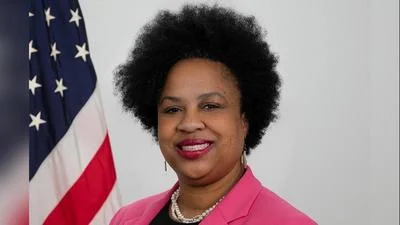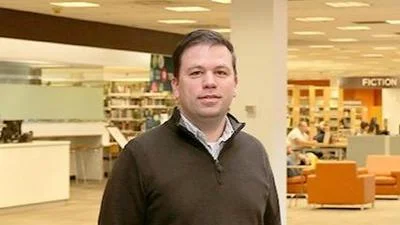Village of Bartlett Economic Development Commission met Jan. 13.
Here is the minutes provided by the commission:
1) Call to Order
S. Gandsey called the meeting to order at 7:01 pm.
2) Roll Call
Present: K Erickson, S. Gandsey, N. Gudenkauf, M Hughes, J. LaPorte, A. Lewensky, R. Perri,
Absent: G. Kubaszko, T. Smodilla
Also Present: T. Fradin, Economic Development Coordinator
S. Skrycki, Assistant Village Administrator;
J. Dienberg, Management Analyst
3) Approval of Minutes
A motion was made to approve the minutes from the December 9th, 2019 meeting.
Motioned by: R. Perri
Seconded by: N. Gudenkauf
Motion Carried
4) Public Comment
None
5) Economic Indicators Report
T. Fradin shared the economic indicators report with the EDC. He shared that four years ago, the EDC completed a Marketing Plan for 2016 through 2020, with the overall goals to guide marketing activities in an effort to continue growing the Village’s economy via increasing private investment through the development and redevelopment of vacant land sites and the numerous vacant commercial spaces at the time.
The EDC recommended establishing a baseline, so elected officials, appointed officials and Staff had a reference point from which to base economic progress in the Village.
Through a combination of increased marketing efforts and a strong economy, the commercial vacancy rate, which stood at 19% in February 2016 per EMSI was reduced to 14.1% in 2017 per CoStar and was further reduced by half to a healthy 7.2% in Q1 of 2018 as the Village’s largest vacant space was filled along with multiple smaller ones.
The vacancy rate had increased to 8.2% as of last year due to the closing of multiple dry-cleaning businesses and a relocation of a 4,000 SF Amita/Alexian Brothers office at Oak & Hickory in the Cartland Building.
Following the completion of the Galleria of Bartlett, which has several vacant spaces, in 2019, the Village’s overall amount of retail/commercial space is nearly one million square feet, only 65,000 of which is currently vacant, for a 6.6% vacancy rate.
Besides a +/- 22,000 SF portion of the former Bartlett Fresh Market space, vacancies are scattered throughout the community and are negligible.
Furthermore, three of the chronically vacant structures, the former Lucky Jack’s building at Railroad Avenue and Oak, the former Tri-County Insurance building at 370 S. Main Street and the Bormann Building at 366-368 S. Main Street (since replaced by Balance Family Chiropractic) were demolished two years ago.
When the EDC completed and approved the 2016-2020 Marketing Plan, the Commission requested to track progress via annual or semi-annual key performance indicators including vacancy rates, number of businesses, sales tax figures, job creation, daytime population, new projects and more.
In an effort to keep members of the Village Board, EDC and residents aware of the progress of this Marketing Plan and to be aware of the Village’s economic strengths, weaknesses and opportunities, the following is a brief summary of various reports that are attached.
T. Fradin then transitioned to sharing an overall summary of Bartlett’s population. Until the results of the 2020 Census are released next spring, like most communities, the Village will continue utilizing population and demographics summaries from ESRI, Community Data snapshots from CMAP and other services to provide information to businesses and developers.
Keep in mind that numerous other types of reports are routinely requested and provided, such as drive-time and distance rings from particular locations, as most customer-oriented businesses are more concerned with trade area demographics than Village-wide statistics.
ESRI estimates the Village’s population at around 41,156, nearly unchanged since the 41,208 from the last decennial Census. Since there have been few new residential developments since that time, ESRI’s estimate seems accurate.
With some new homes at Bartlett Pointe West, the potential for an infill apartment project in the Downtown at Opportunity Site E and the potential for multifamily housing at Route 59 and Lake Street, the Village’s population could increase somewhat, but unlikely by a significant amount prior to the Census.
ESRI and CMAP both estimate median household income in the Village as right around $100,000 even, which reflects a per capita income of approximately $41,000 based on the income received by all persons aged fifteen and over divided by the total population.
Daytime population remains a challenge, with ESRI estimating 9,847 (up 400 since last year) workers in the Village and 19,000 residents present during daytime hours for a total daytime population of 28,800. JobsEQ estimates 10,155 employees within the Village at the close of Q3 2019.
The Census Bureau’s OnTheMap application provides greater detail on this metric, reporting 8,447 workers in the Village during daytime hours (up 1,300 from last year’s report), 7,415 who come from elsewhere and 1,032 who both live and work in the Village. It shows 21,923 residents leaving the Village per day for work, resulting in a net loss of about 14,500 people from the Village.
While the Village still experiences a significant net loss of daytime population, please note that this metric has been steadily improving throughout the five years of staff reporting the Economic Indicators as the Village’s business parks have continued developing.
Two things to keep in mind: (1) estimates by the Census Bureau are always several years behind, thus do not reflect some of the expanding businesses in Brewster Creek Business Park and Blue Heron Business Park and (2) that these numbers continue to reflect the “bedroom community” character of the Village prior to the development of these business parks.
With the Village Board’s, EDC’s and Staff’s continued efforts to enhance the local economy and attract office, industrial and retail development, the balance of inflow/outflow of workers should continue to grow in terms of inflow.
This being the fifth year of this report, prior years showed a net loss of 15,800 people in 2015, 17,000 people in 2014 and 17,500 in 2013.
The race/ethnicity of the Village continues to skew primarily White alone at 78.6%, followed by 14.4% Asian and 8.6% Hispanic. It is worth noting that the Asian population, which includes those of Indian origin, has been rising steadily since we have tracked population demographics in the Village. The first demographics report that I obtained in July 2006 showed an Asian population of 10.5%.
The population continues aging, with a median of 39.2 (38.8 last year) and the housing is predominantly owner occupied at 83.8%. 71% of the housing stock is comprised of single family detached homes with another 17% single family attached (townhomes).
The population aged twenty-five and older holding bachelor’s degree or higher has increased steadily over the course of the past ten years and now stands at approximately 44% (32% Bachelor’s and 12% Graduate or Professional). This is considered a key metric by some of the higher end grocers.
The Village’s unemployment rate is currently at 2.5%, by far the lowest measurement since prior to the Recession.
Further information on demographics, housing characteristics, educational attainment and much more is attached in multiple reports.
Business Summary
At present, there are over 300 licensed businesses in the Village, an increase over the past several years, through a combination of new business openings and increased effort in ensuring that all businesses obtain licenses. Some new ones over the past year include the Bartlett Tap, the Beef Shack, 2X20 Fitness, Orangetheory Fitness, Gambit’s, Cherry on Top Ice Cream Shoppe, Armanetti’s, and Squeeky G’s car wash.
Coming soon businesses include 120 Live, who will be appearing before the Village Board next week for its BEDA grant application, One Taco Dos Tequilas at Streets of Bartlett, some new concepts to the Shoppes at Banbury Fair and MORE Brewing’s free-standing brew pub at the former Lucky Jack’s site on Railroad Avenue.
Staff also continues working with Manny Rafidia, who purchased the former Bartlett Plaza last year and has rebranded it Streets of Bartlett, to fill the remaining vacant spaces in the center. On the industrial side, we are working with multiple business prospects to fill the remainder of Brewster Creek Business Park as well as several considering sites in the Blue Heron Business Park.
There are still approximately three hundred Home Occupation permits in use.
Retail Occupancy
The most positive news in this summary is the dramatic decrease in the Village’s commercial vacancy rate, alternatively viewed as an increase in the occupancy rate.
As staff continues working with property owners, their brokers, area entrepreneurs and others interested in starting or expanding their business, the occupancy rate has steadily improved on a year-to-year basis, from the mid-teens in 2016 and 2017, to 8.2% in Q4 of 2018 down to a low of 6.5% in Q4 of 2019 and 6.6% at present.
Because the Village has few big-box retailers, we have not experienced major vacancies over the past few years as many have declared bankruptcy and closed stores. Per today’s CoStar report, the Village’s commercial and retail vacancies are scattered throughout strip centers in every area of the community from Lake Street to Army Trail Road.
We also continue engaging with potential single-use commercial uses, so there is potential for additional build-to-suit commercial projects to come online in the next year or two including a day care facility, a QSR and fuel stations.
As an active member of ICSC and Access O’Hare West (AOW), we will continue aggressively marketing the available spaces throughout the coming years to better position the Village as having a diversified economy not too dependent upon any particular business or sector.
Sales Tax Revenues
Sales tax revenues collected by the Village remained flat from last year after having increased for many years, with the Village receiving $2,383,743 in disbursements from the State, indicating $238.4 million in taxable sales from July 2018 through June 2019. The Village created a Home Rule sales tax in 2018 which began in October, resulting in an additional $1,220,542 in sales tax collected over the final nine months of the same period.
Per the SIC Code reporting from the Department of Revenue, sales in the DuPage County portion of the Village continue to roughly triple those in the Cook County portion with the largest sales categories remaining Agriculture & All Others; Lumber, Building and Hardware; Automotive and Filling Stations; Food; and Drinking and Eating Places. Drinking and Eating Places is the largest sales tax generating category in the Cook County portion of the Village as reflective in the growth of that category in the downtown area, Westgate Commons and along Lake Street.
Industrial Occupancy
The Village’s industrial vacancy rate has recently hit an all-time low. At only 3%, there are few available spaces currently available and I met with a potential tenant for one of the spaces on Hecht Court earlier today.
As the two new speculative buildings under construction by Logistics Property Company (LPC) are completed, over 400,000 SF of inventory will hit the market in the coming months with no tenant yet in place. As the former Main Steel building on Devon Avenue is completed, another 120,000 SF will become available, potentially adding half a million square feet of vacant space to the Village’s inventory.
As I have previously reported, the Chicago area industrial real estate market remains hot, and the buildings in Bartlett are well-positioned to attract new and expanding companies. While the industrial vacancy rate may temporarily increase through late 2020 into early 2021, we expect the rate to fall back into the single digits by this time two years from now.
It should also be noted that the Village Board recently approved “Project Oak,” a new 400,000 SF facility for McKesson, on a 26-acre site in the Cook County portion of Brewster Creek Business Park. As that building will be fully occupied upon its completion, that will help boost the occupancy rate as well.
There remain three occupied buildings in the Blue Heron Business Park, all build-to-suit projects. A fourth building, a 102,000 SF facility for Cathay Industries, is nearing completion, and Staff is working on two additional projects for the business park – a landscaping business yard and a therapeutic school called Parkland Preparatory Academy which is relocating and expanding from a leased location in Streamwood to a build-to-suit facility in the Village.
Both staff and the owner of the Blue Heron Business Park are engaging with other prospective businesses and we anticipate several more coming in this year and next.
Office Occupancy
Since the Village does not have a large amount of office space, only 278,000 SF classified as such, the occupancy rate has fluctuated between 89% and 98% over the past five years. There remains only 16,000 SF or 8% of available office space at present, most of which is split between the Barrington Orthopedics building at 864 W. Stearns Road, the Woodland Hills Professional Center at 1110-1124 Schick Road and some spaces at the office portion of Westgate Commons.
Because there is no one single office user of major significance in the Village, this number should remain consistent through 2020 and beyond.
Summary
While there is no one metric by which developers or businesses select new locations, it is important for elected officials, appointed officials and staff to have a firm grasp of the economic indicators of the community we serve.
As a long-time economic development professional, I have been asked to provide information on traffic counts too many times to count, information on senior housing for housing developers and breakfast restaurants, daytime employment for a wide range of businesses, number and age of automobiles for an auto parts store, ethnic statistics for a number of restaurants, income and education level statistics for nearly every business and so on.
Bartlett is well-known as a safe, family-oriented community with a small retail and office base and a thriving, expanding industrial base. As the business parks continue to develop and as the Brewster Creek TIF expires in 2022, the Village will have boosted and diversified its tax base as well as significantly increased the daytime population from only a few thousand employees to well over 10,000.
As staff continues to implement the Downtown TOD Plan to increase the viability of the downtown area and the 2016-2020 Marketing Plan to attract investment to undeveloped areas throughout the Village, we anticipate reporting increased occupancy rates and decreased daytime population loss in the coming years.
Tony then walked the commissioners through the highlights of the different supporting documents in the packet and opened up the floor to questions from the commissioners.
S. Gandsey asked how the crime statistics are determined, and if it is specific to violent crime.
T. Fradin stated that those statistics are based on violent crime, as it does not necessarily include property crime. He stated that he will look into it and gather more information. He added that Bartlett is always ranked near the top in terms of safety.
R. Perri stated noted that the Village is in a period of dynamic economic activity that is also occurring throughout the state and the country. He stated that the economic tools that the President put into place have helped everyone and he personally is glad to have a President that knows a little bit about economics.
T. Fradin added that economics goes in cycles, and that at this time staff has capitalized on the all of the situations going on at the local, county, state and national levels and that staff is always trying to attract development. He added that there are challenges in being in three different counties, but staff is overall grateful to the current situation, as staff continues to try to position themselves as well as possible while we are in a time of good economic situations. He added that while he enjoys reporting these good numbers, that they will not last forever. He also added that the Chicago area market is very strong at this time.
S. Gandsey complimented staff on positioning the community well for any opportunity that arises. She added how important it is for staff to have the data on hand for any situation.
T. Fradin thanked Commissioner Gandsey for the compliment and added that staff is always doing everything they can to be prepared with the proper data and metrics.
M. Hughes stated that while things seem to be on the upswing and going well, it seems unusual that the sales tax has remained flat.
A. Lewensky agreed with Commissioner Hughes’s statement and added that he was going to point out the same thing.
T. Fradin stated that he hasn’t developed a specific theory on this, but added that the growth Bartlett has seen, hasn’t necessarily been in retail. He added that staff views it as a positive that they are remaining relatively flat on sales tax production based on the fact that not many sales tax producers have been added. He added that in order to see a large jump, its more likely to see that when a “bigger fish” comes into town. He added that a new business like MORE Brewing is one that will bring residents from other communities, and can help see that number grow, where current businesses cater more to Bartlett residents and are not a huge draw to people outside of Bartlett.
K. Erickson added that there are so many people in Bartlett that work outside of Bartlett and spend their money buying gas, groceries, and other shopping in the communities they work.
T. Fradin also added that Amazon and other online shopping have affected this as well, as those sales tax dollars go to wherever the point of sale was, not necessarily to the community where the items were ordered.
R. Perri asked if the Village is pursuing a dealership to take advantage that type of sales tax revenue, or if the village does not have the necessary land available.
T. Fradin responded that it is becoming more challenging, but the Village has pursued dealerships very hard in the past and will continue to pursue them. He said that that was a main focus of the Village owned land at Lake and 59, but it did not pan out at that time. Tony added that Village is currently looking at bringing in an apartment developer to that site at this time. He added that many dealerships like to be in an “auto-row”, and the village simply doesn’t have an area like that that would appeal to those dealers.
J. LaPorte asked Tony to verify the total number of sales tax generated.
T. Fradin stated that it was roughly 238 million dollars in taxable sales. He stated that the Village collects 1% of a local sales tax, and another 1% in home rule sales tax. He stated that the total number of sales is roughly the $238 million divided by one hundred. He also added that many grocery items are not taxed, and that that number does not fully represent the total sales in the village. He added that the RV dealership has been doing well in the last few years and that they are a large contribution to that total number.
N. Gudenkauf asked what the home-rule sales tax is.
T. Fradin stated that it is an additional 1% sales tax that the village levies as a part of their home rule authority granted by the state.
N. Gudenkauf asked if Bartlett has a transfer tax for when people move out of the Village. T. Fradin stated that there is an exit tax.
S. Skrycki clarified that if you move, but stay in Bartlett, you do not pay the tax.
A. Lewensky asked if the Home-Rule sales tax has affected business recruitment in any way. T. Fradin did state that some businesses struggled implementing it to their P.O.S. systems.
S. Skrycki stated that the Village is still much lower than surrounding communities who impose either a 1.5% or even 2%, adding that it actually gives the Village an edge in terms of recruitment.
6) New Business
T. Fradin stated that there isn’t much to report in terms of new business, but added that in the coming meetings staff is looking to show off some projects on the website that are near completion and will also continue to recruit businesses to the BEDA program.
S. Gandsey asked how much of the BEDA money is left
T. Fradin stated that half will be left upon board approval of the $50,000 120 Live application. S. Gandsey asked if staff had an update on MORE Brewing.
S. Skrycki stated that the owners are almost finished with their Huntley location, and that they will shift their focus to Bartlett once that is completed. He added that Huntley should be open within a month or so.
S. Gandsey asked if there is a date that they have to start groundbreaking by.
T. Fradin stated that there is a date in the contract, but did not have it in front of him, but added that they recently went before the Village Board to have that date extended. He stated that they plan to close on the property late spring, early summer.
N. Gudenkauf asked if the Bartlett Tap is still open.
T. Fradin stated that there have been a few issues and inconsistencies with their hours, but as far as he knew they were still open.
J. LaPorte stated that they were closed for two weeks over the holidays for the owner’s vacation.
S. Skrycki added that staff will be scheduling a meeting with the owner in the near future. 7) Adjournment
A motion was made to adjourn the meeting.
https://www.village.bartlett.il.us/Home/ShowDocument?id=10758






 Alerts Sign-up
Alerts Sign-up